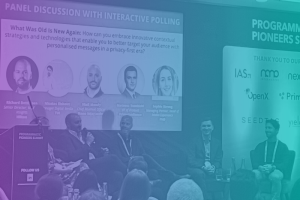Programmatic Pioneers was another fantastic summit, and meeting of the great and the good in marketing and advertising last month.
Following the event, I noted down some of the major challenges and opportunities I see for brands and agencies right now, from where Nano sits, at a time of change and renewal:
1. The Bad News: Chrome Cookie Deprecation is Just One Symptom of Signal Loss
The first thing I’d say is that Chrome cookie withdrawal was first mooted by Google all way back in 2019. And then Apple ran with the idea, killing cookies on Safari in 2020. So, it’s not like there hasn’t been plenty of time to prepare already, whether it’s Q4 2014 or H1 2025 we see the actual ‘cookie extinction event’.
Just to add to this briefly, I think there is a huge overfocus on this topic, and we really are missing the bigger picture – don’t shoot the messenger, but it’s not just cookies on the way out. A long series of other people-based signals, from the IP address, to link decoration, to location, to SDK targeting are being whittled away by tech giants and legislators alike. So if we’re being honest, let’s call this what it is – signal loss as a wider trend, not just cookie deprecation.
Just to go back to cookies, and another reason this debate is a red herring – our own research has shown that around 70% of consumers are already pre-empting Chrome – 70% are taking their own steps weekly or more to render cookies pretty much redundant regardless. That is, using VPNs, declining cookies, incognito mode etc.
Key Quote from Programmatic Pioneers:
Kimberly-Clark’s Helen Brooks reminded us that “cookies made us lazy.” With cookie deprecation, we now have a broader perspective on audience engagement, moving away from the tunnel vision of the past.
2. The Good News: Contextual & Intent Targeting is On the Rise, at Just the Right Time
If you accept that people-based signal loss is an ongoing trend – and according to the IAB US’ State of Data 2024 report, 95% of the industry does – it seems likely contextual will play a bigger role in future.
What we are facing is threefold: actions by tech gatekeepers, actions by legislators and actions by the consumer – and they all point to reducing people-based signals, reducing profiling. Contextual is the only clear alternative that has the potential to be genuinely future-proof in the face of that triple threat.
In the short-term post-cookie, I predict we’ll likely see a continued dependence on other cookie workarounds, for example IP addresses – even if they are already heavily associated with fingerprinting. And if what we hear of what Google/Apple etc are planning is true, IP will then very likely be next in the crosshairs.
And so, you can see the cookie story repeating itself, even as the smart money goes to context and intent.
3.Where to Look for Innovation Right Now: at the meeting point of AI, contextual and targeting real-time intent
I think the reality is that what we now call contextual bears little resemblance to its origins. This is in a big way due to widely publicised advances in AI and machine learning, which if anything have led to greater advances here than in audience-led approaches.
How that looks in practice is a move from simply looking at keywords, to understanding the meaning and sentiment of content, the ability to support a large number of languages, and the ability to identify and target ‘entities’ within the world of intent – so if we were talking about a football tournament for example, not only teams, but specific matches, venues, individual players, referees, VAR decisions, past rivalries and any number of other factors that you can think of.
Key Quote from Programmatic Pioneers:
Sky’s Emma Dunford stressed the importance of balancing art and science in marketing, reminding us to “go back to remembering we’re marketers.”
4. The Elephant in the Room: How is Measurement Affected by Signal Loss, and How Does it Recover?
The impact of cookie phase-out on targeting effectiveness is widely publicised – less so campaign measurement – even if it is another big challenge.
For our part, we have launched a partnership with Circana, allowing advertisers to measure performance results without cookies or other IDs. This method makes use of aggregated point of sale data to measure sales uplift, instead of profiling individuals. So there is the consumer and privacy benefit – but it’s also about future-proofing – whereas using a cookie workaround, clients may have to completely revise their approach again in a year’s time, just as they are looking to now with Sandbox.
On the targeting accuracy piece, our Intent Personas product launched last year combines advanced intent and contextual methods with good old fashioned panel research. So the targeting choices we make for each audience are backed up and verified by ‘real-world’ data.
Key Quote from Programmatic Pioneers:
PHD’s Sophie Strong said: “CTR’s do not show intent. Accidental clicks are an under-discussed issue. Work needs to be done to change this default metric,” urging us to rethink our measurement standards.
5. The Buzzword of the moment: Generative AI and What it Means for Advertising
I mentioned languages, meaning, sentiment, entities earlier… what I would add is just a note of caution alongside the genuine excitement around this topic which I think we all feel.
The Cambridge Dictionary’s word of the year for 2023 was ‘hallucination’, describing when generative AI returns persuasive, but ultimately incorrect information.
It’s a good reminder of the challenges, alongside the vast potential we see with each new wave of innovation. Smart motorways and self-driving cars are two examples where the promise of AI hasn’t perhaps lived up to the hype.
The way forward is not to treat AI as total automation or ‘set and forget’ – instead it’s about tying the technology to real-world checks and verification. That is how you avoid ‘hallucinations’.
And let me give a concrete example, to show this is not all theoretical – and can be done: Our Intent Personas product provides demographic targeting, but without cookies, IDs or people-based data and profiling. How do we ensure the tech behind it is on track? Those targeting choices are cross-checked against our own panel of humans. People belonging to those same demographic groups.
As someone once rightly pointed out, AI is only AI until it has a practical use case – then it just works.
Key Quote from Programmatic Pioneers:
AutoTrader’s Camilla Ellerton emphasised the importance of using AI wisely – “We mustn’t use AI for the sake of it. It shouldn’t distract us from the grassroots of what good marketing is set out to do.”







